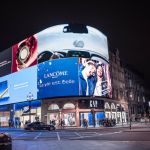Creating a sense of place is notoriously difficult, drawing on both psychic and physical factors. But digital signage has offered a new approach for creating the idea of a neighbourhood in retail and public spaces.
A Sense of Place
Covent Garden, London. The Marais, Paris. Soho, New York City. The French Concession, Shanghai. In the modern era the most commercially successful and iconic shopping destinations offer visitors more than a traditional retail experience. They have the feeling of a cohesive neighbourhood, with its own unique character, aesthetics and reputation. This atmospheric charm attracts both shoppers and retailers to the destinations in droves.
Traditionally the reserve of urban planners and architects, are increasingly realising the commercial benefits of creating a “sense of place” within shopping destinations. While undoubtedly heritage plays a role in creating this feeling, creating a neighbourhood goes beyond the history. But how can brands, retailers and local stakeholders begin to tackle this notoriously difficult task?
Consumers, especially within the luxury sphere, are increasingly demanding an immersive and multi-faceted experience, beyond simplistic transactional consumption. If they desire a seamless journey to product, they shop online. With in-store experiences, the product itself has now become a souvenir of the shopping experience – obviously important, but not the sole attraction. Consumers want to indulge their senses, be entertained, and attach emotional meaning to the brand.
One way to create an continuous experience that reaches outside of the single store or branded space is to act cohesively with other partners within the geographic area to create a neighbourhood. To do this, destinations are turning to the formerly architectural disciplines of “wayfinding” and “place-making” to create a sense of place.
Wayfinding and place-making are both approaches which can help develop the psychic narrative of a destination – giving visitors a sense of meaning and ownership over a given geographical area. Whilst place-making uses aesthetics to create a common culture in a given building, complex or area, wayfinding employs physical signposting and markers to create a sense of “flow” in the routes taken through it. Both seek to link the psychic sense of a place to its physical attributes. While neither process can be entirely templated, as each neighbourhood is unique with its own contextual factors, there are certain factors in common.
Sign-Posting
There are several ways in which digital signage can complement a place-making project. Dynamic, interactive wayfinding installations use digital signage to encourage visitors to explore a neighbourhood, surprising and delighting passers-by. Examples of these include zebra crossings that light up when approached, making dark neighbourhoods safer and more appealing. Points by Breakfast have also designed interactive signs that react to their surroundings, changing their text and direction and even reflecting social media activity as it happens.
Reactive and dynamic signage reflects the changing fabric of destination themselves, and can show that a retail destination is forward-thinking. Conversely, it can add an interesting juxtaposition – adding a modern accent to historic areas. Wayfinding can also lead visitors down favoured routes to highlight cultural happenings, architectural features or commercial focuses of the destination.
Digital signage is also one, relatively painless, way in which different partners can collaborate and coordinate as they try to create a sense of place, offering a degree of both flexibility and cohesiveness. For example, through publicizing a joint campaign.
Wayfinding and place-making go beyond the physical into appeals to human psychology; as such, they are tricky, somewhat unpredictable disciplines. However, digital signage can certainly be one element employed to begin creating a sense of psychic place.
If you require any further information, do not hesitate to contact us by filling the form, by phone +34 881 874 259 or by email sales@malerdso.com.











